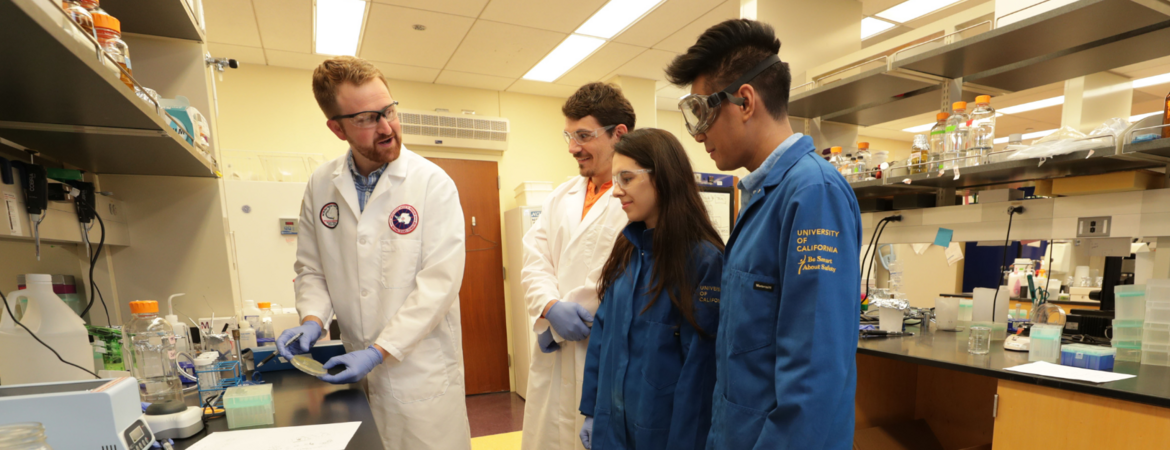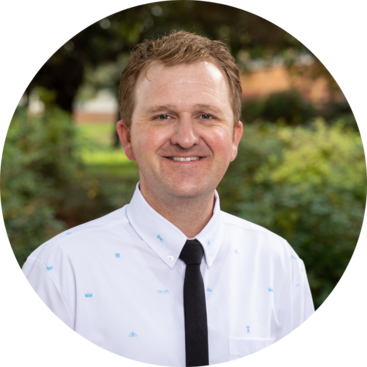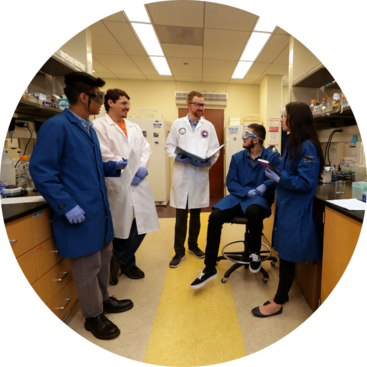
To say that Adler R. Dillman is fascinated by a particular ubiquitous organism best viewed through a microscope is a bit of an understatement.
A Professor of Parasitology & Nematologist as well as the Chair of the Department of Nematology at UC Riverside, Dillman is “all about” parasitic nematodes...although, to be sure, he had never heard that classification as a kid growing up in Orem, UT, just south of Salt Lake City.
“I had never heard that term before until I was an undergraduate, maybe not until 2003,” he says. But, Professor Dillman did grow up loving science fiction, and that interest stoked his imagination vis-à-vis what later became the world of parasites and especially nematodes.
“As a child of the ‘80s, we had many great books and films,” he says. “I LOVED the whole Alien movie franchise...when I first learned about nematodes, these parasites of insects, to me they seemed like they could be something right out of a James Cameron movie!”
“It was really interesting to me," he continues, "the notion that you could have this worm that crawls into its host through natural openings and gets into the blood of the insect host and defecates out highly pathogenic bacteria into the blood of that insect. Together, the nematode and the bacteria it’s defecated out, kill the insect and liquify all the tissues...and then about a week later, what started out as 10-50 parasitic nematodes at the initiation of infection has grown to tens of thousands of parasitic nematodes that emerge from the cadaver!”
In his upcoming, Science Lecture Series presentation, Parasitic Nematodes: Masters of Disguise, Professor Dillman plans to discuss how parasitic nematodes kill their hosts and are at the same time masters of immune modulation.
“That’s important to human beings,” he says, “because we have a lot of autoimmune disorders that are based on wonky disregulation of immunity. Research suggests that parasitic nematodes can bring back into regulation a previously disregulated immune response. We are looking at using parasitic nematodes as a therapeutic to treat autoimmune disorders like Crohn’s Disease, inflammatory bowel disease, even celiac disease."
Professor Dillman adds, "We still don’t really understand how nematodes suppress the inappropriate immune response, but it’s fascinating.”
In layman’s terms, nematodes are round worms. “I would normally say they’re microscopic round worms, but there are exceptions to that...some are visible to the naked eye,” Professor Dillman says. “If you go to the zoo, most of the things you see are all part of one phylum, the phylum Chordata...animals with a backbone and a bundle of nerves running down their back. Nematodes are a whole other giant taxonomic group...they’re all unsegmented roundworms.”
According to Professor Dillman, while many nematodes are parasitic, most are not. Some can be found existing in marine and fresh water environments. Others, he says, are “soil-dwelling” but not parasitic, and feed on fungi and bacteria. “But then, of course, you have a small proportion, maybe 15 percent of the that are described, that are parasites of plants and another 10 percent that are parasites of animals,” Professor Dillman says of the approximately 30,000 nematodes that have been discovered so far.
The nematode-to-human threat, in Professor Dillman’s view, is enormous and often underestimated. “You have this huge threat in plant-parasitic nematodes, which puts at risk the very food we consume,” he says. “I don’t do research on that particular group, but most of my department does. I’m focused on the second part of this, which is the direct threat of parasites to human health via being parasites of humans and livestock.”
There are more than 1 billion people on Earth who are infected with one species of nematode. Professor Dillman says that when other infectious parasitic nematodes are added to the mix, potentially 3 billion people could be infected, with some infected by more than one nematode.
“You have this species called Ascaris lumbricoides, which is about 8-10 inches in length and as wide as a green bean,” Professor Dillman says. “It sits in the small intestine of humans, and there are 1.2 billion people infected with that one nematode right now!”
Not including James Cameron, two people figured prominently in Professor Dillman’s path to the microscopic universe of nematodes. The first was his uncle Drew, a plastic surgeon and self-taught naturalist. “He was very interested in birds, plants and to a lesser degree, insects,” Professor Dillman says. “As a kid, when we would go out hiking with him...he was one of those people that stopped at every single plant or tree and quizzed me about it. It drove my dad crazy...he wanted to keep hiking, but with Uncle Drew, we were going to look at every single thing along the way.”
From his uncle, Professor Dillman learned the scientific names of plants, how to identify them, and why they were named what they were named. “When we went to the natural history museum, we had to stop and read every plaque,” he remembers. “I loved that one person could know so much. That inspired me.”
After two-years serving a mission in Bucharest, Romania for the Church of Jesus Christ of Latter-Day Saints and teaching at missionary training center in Utah, Professor Dillman pursued his desire to become a scientist. “At Brigham Young University, my major was microbiology,” he says, “but I hadn’t had any research experience, so after I had been a teacher at the missionary training center for a year, I was trying to figure out what classes I was going to take next.”
As Professor Dillman tells it, he was in the middle of his sophomore year and on his way to meet his science counselor with the burning question of whether to take a particular physics or statistics class to meet a course requirement.
“It was pure happenstance that I met a faculty member in the hallway by the name of Byron Adams,” he says. “He stopped and asked me what I was doing. I had never seen him before and didn’t know him. He asked if I was interested in research. I responded affirmatively and he told me he was a new faculty member and was having his first lab meeting on Monday and asked if I would come. It turned out that Byron was the person who introduced me to Nematodes.”
Everything clicked for Professor Dillman after that meeting. “When I was in the lab, all these abstract ideas about DNA replication and transcription made sense,” he says. “I was doing PCR in his lab, and he allowed me to go to scientific conferences and present research, and actually took me to Antarctica as part of his research program!”
Professor Dillman adds, “I spent five weeks sampling for nematodes in The Dry Valleys out there. That set me on a path – looking at nematodes under a microscope, digging for them in the soil, growing them on lab plates. I was in love and am still intrigued by these delightful organisms.”
Professor Dillman came to teach at UC Riverside full-time in 2015, but his first experience with Nematology at UC Riverside was when he was an undergraduate at BYU in 2005. He responded to an advertisement looking for students to travel to the Republic of Moldova in part to research nematodes, but also as a goodwill excursion. Due to his previous missionary work in Romania, Professor Dillman was a natural fit.
“I went with a faculty member, Ed Platzer, who at the time was Professor of Nematology and Biology at UC Riverside,” he says. “That was my first experience getting to know UCR, and the high quality of research being done at the college deeply impressed me. Imagine my surprise when in 2015 I was offered a faculty position! I’ve always been a fan of UC Riverside’s research prowess...in my line as a nematologist, it is one of the premiere places to conduct research on nematodes because of its stellar faculty.”
Beyond the faculty, Professor Dillman’s admiration extends to UC Riverside's students, who he finds to be hardworking, diligent and rigorous in their pursuit of academic excellence.
“I teach a class of more than 400 students,” he says, “and I find that the students who are really interested and motivated are among the best and brightest students I’ve ever worked with anywhere, and that includes Caltech, where I did my Ph.D. and Stanford, where I was a postdoc.”
The Department of Nematology at UC Riverside was created in 1954 and is currently home to seven faculty members. It also bears the distinction of being the the only unhyphenated Nematology department in the entire U.S. While there have been departments of Nematology at UC Davis, the University of Florida and other universities located in the Midwest and on the East Coast, over time they have all merged with other departments.
“In my experience, I kind of feel we’re at a point where there’s a push to move away from organismally-focused departments...the only exception to that is that you still have a number of universities with entomology departments,” Prof. Dillman says. “I think now the focus is more on neurobiology or ecology and evolution or molecular biology – we’ve gone away from organismally-focused entities.”
Over the course of his career, Professor Dillman has been the recipient of an Outstanding Investigator Award from the National Institutes of Health (NIH) and the Chancellor's Award for Excellence in Undergraduate Research and Creative Achievement from UC Riverside. The Nematology lab at UC Riverside is currently funded by the NIH, the National Science Foundation, and the United States Department of Agriculture.
The laurels, while nice to get, rank down the list of Professor Dillman’s proudest achievement to date: investigating a “cocktail” of sorts.
“When I started my research lab here, we did some really nice experiments illustrating that the nematodes themselves release a cocktail of toxic proteins into the insects that they infect.” he says. “This cocktail by itself is highly lethal to insects. So, I kind of upended the dogma that the nematodes only served as a vector. A lot of my research today is still focused on identifying the components of that cocktail and how they cause death in the insect and how other components are involved in modulating the immune response of the host.”

